As I think about the recent case and situation involving Starbucks (Click Here), the company is trying to determine if the actions of the manager in question were not only discriminatory but also if the manager knew the decision was made based on race without even realizing it. The manager asked African American customers who weren’t making a purchase to leave and later called the police. One thing I emphasize and had noted in the below article (first published in The Times of PAMAC, Volume 8, Dec’17), is to make Unconscious Bias awareness a part of the Organization’s Onboarding Program.
I had the opportunity to experience Professor Mahzarin Banaji’s Unconscious Bias (UB) awareness program. I was lucky to spend an hour in a cab ride with her on the roads of Mumbai discussing our journeys and the role of cognitive biases in our careers. Prof. Banaji is the Head of Psychology Department at Harvard University & is also the co-author of the book, Blindspot: Hidden Biases of Good People. It was during her UB session, when we used the Implicit Association Test (IAT), that I realized even though I have been a working woman all my life, a big advocate of female education and empowerment, have a husband who shares an equal responsibility at home, have a mother who never differentiated between me and my brother, still I could associate a woman with household chores slightly faster than I could for men. I wasn’t sure whether it was because of how the society works but I was shocked because I have been blessed to experience diverse cultures, countries and have friends & colleagues all over the world. It was quite an Aha moment for me to realize my own biases and that made me do a deep dive on this subject. Specifically, how dealing with UB can increase opportunities, make the workplace more inclusive and drive the bottom line.
Unconscious Bias is the split-second, automatic evaluation the brain does to make every-day as well as complex decisions about people and situations. There are some 20 Cognitive Biases that affect our everyday decisions and in ways that we don’t even realize. We receive 11 million bits of information every moment – we can only process 40 and so the brain takes a mental shortcut. It is also said that we make up to 35000 decisions every day. Our environment, experiences and emotions can profoundly influence our decision making.
And when we speak about workplace, these biases have a deep impact on how leaders make decisions. One such visible impact we all can see is the gender diversity in the workplace. Despite so many benefits and need of Diversity & Inclusion, the current practices affect the recruitment, selection, pay, development, and promotion of women.
Few Examples:
Career Opportunities – Globally, women have 11.2 Trillion dollars of purchasing power and in the US, American women have $5 trillion purchasing power, over half of the US GDP. In Japan, closing the gender employment gap would increase Japanese GDP by 13% and we still have miles to go. Unconscious Bias plays a big role, as they say birds of same feather flock together and people end up hiring and promoting their mini me versions. This is also an example of Affinity bias. The result of the 2016 USA elections is an example of the highest glass ceiling. Major corporates’ global priority is to have more women in their senior leadership roles.
Equal pay – It is surprising that women are good at bargaining while shopping but when it comes to negotiating for themselves they are not so confident. Linda Babcock did a study for her book “Women Don’t Ask”, she found that there was a 7.6% difference between the salaries that women MBAs get compared to what men MBAs get. She found that post getting the offer, only 7% of women attempted to negotiate while 57% men did. The ones that negotiated, got an increase of salary by over 7%. So, if women and men negotiated in similar proportions, that 7.6% difference would be cut dramatically.
Maternity – Body clocks are ticking, the emotional desire to become a mother takes priority and the Catch-22 that comes with it can be a make or break situation. While corporate benefits are getting better, the mindset around mothers with career ambitions is yet to change.
Beauty Bias or Candidate’s personal characteristics (attractiveness, age, and gender) – We tend to think that most handsome individual will be the most successful. For example, while 60% of CEOs in the US are over 6 feet, only 15% of the total population is over 6 feet tall. And while 36% of US CEOs are over 6.2 feet, only 4% of the US population is over 6.2 feet tall. This shows there is some bias in terms of how we perceive a CEO should look like. In recruitment or succession planning, it’s common that recruiters or leaders will look to fill a role with someone who they believe looks like the kind of person who should have the role based on their preconceived bias. There are a few studies which prove that obese men and women are less likely to get selected for an interview compared to their leaner peers.
Leadership Development Programs – Even though corporates globally are spending millions of dollars every year to accelerate their High Potential High Performing diverse talent, the pipeline is still not diverse.
Dunning-Kruger Effect – Unskilled individuals overestimating their abilities and experts underestimating theirs. When you bid on roles and look at the job descriptions, men would confidently apply even if they meet 50% of the criteria whereas women would hesitate to apply even if they meet 75% of the criteria. Innovative tools are being used by some corporates to make the job description language more gender neutral.
Few useful ways to manage your bias:
· Take the free online Implicit Association Test, https://implicit.harvard.edu
· In a team meeting, make sure all voices are being heard
· Get out of your comfort zone, increase the diversity of your network
· In talent decisions, ask yourself am I thinking broadly or am I just looking for “mini mes”
· Check out https://outsmartinghumanminds.org/
Few practices that Corporates may do to be more inclusive:
· Create awareness with UB talks for all the employees
· Incorporate trainings on UB to first line leaders and leaders developing leaders, make it a part of other training programs as well
· Collaborate with Performance & Development to build nudges to alert us to our hidden biases in the P&D approach
· To drive accountability and results, measure and share the representation reports
https://www.linkedin.com/pulse/unconscious-bias-onboarding-program-must-have-monika-navandar/

